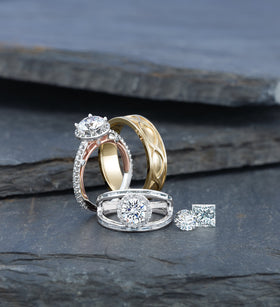email:pangelucci@gmail.com

Are Lab Grown Diamonds Real?
Are Lab Grown Diamonds Real?
- Introduction
Diamonds have long symbolized love, commitment, and luxury. Traditionally, these precious stones were extracted from the earth through mining—a process often associated with environmental degradation and ethical concerns. In recent years, however, technological advancements have enabled the creation of diamonds in laboratory settings, identical in composition and appearance to their natural counterparts. This innovation has reshaped consumer perceptions and choices in the diamond market.
- What Are Lab-Grown Diamonds?
Lab-grown diamonds, also known as synthetic or cultured diamonds, are real diamonds produced through technological processes that replicate the natural conditions under which diamonds form. They share the same physical, chemical, and optical properties as mined diamonds, making them indistinguishable to the naked eye. Despite common misconceptions, lab-grown diamonds are not fake; they are genuine diamonds, differing only in their origin. https://angeluccijewelry.com/collections/solitaire-pear-marquise-oval-and-emerald-shape-engagement-rings
III. How Are Lab-Grown Diamonds Made?
The creation of lab-grown diamonds involves two primary methods:
- High Pressure High Temperature (HPHT): This method simulates the high-pressure, high-temperature conditions deep within the Earth's mantle. A small diamond seed is placed in carbon, subjected to extreme pressure and temperature, causing carbon atoms to crystallize around the seed, forming a larger diamond.
- Chemical Vapor Deposition (CVD): In this process, a diamond seed is placed in a chamber filled with carbon-rich gases. The gases are ionized into plasma, breaking molecular bonds, and allowing carbon atoms to deposit onto the seed, layer by layer, growing a diamond over time.
Both methods produce high-quality diamonds suitable for use in fine jewelry.
- Advantages of Lab-Grown Diamonds
Lab-grown diamonds offer several notable benefits:
- Ethical Considerations: Since they are created without mining, lab-grown diamonds avoid the human rights abuses and conflicts often associated with diamond extraction.
- Environmental Benefits: The production of lab-grown diamonds generally has a smaller environmental footprint compared to traditional mining, reducing land disturbance and carbon emissions.
- Cost-Effectiveness: Lab-grown diamonds are typically more affordable than mined diamonds of comparable quality, allowing consumers to purchase larger or higher-quality stones within the same budget.
- Quality and Availability: The controlled environment of lab production ensures a consistent supply of high-quality diamonds, available in various shapes, sizes, and colors.
- Lab-Grown Diamonds vs. Diamond Simulants
It's essential to distinguish between lab-grown diamonds and diamond simulants:
- Diamond Simulants: Materials like cubic zirconia and moissanite resemble diamonds but differ chemically and physically. They lack the durability and brilliance of real diamonds.
- Lab-Grown Diamonds: These are real diamonds, identical to mined diamonds in every aspect except their origin. They offer the same hardness, brilliance, and fire as natural diamonds.
VII. Certification and Grading of Lab-Grown Diamonds
Like natural diamonds, lab-grown diamonds are evaluated based on the 4 Cs:
- Cut: The quality of the diamond's facets and angles, affecting its brilliance.
- Color: The absence of color, graded on a scale from D (colorless) to Z (light color).
- Clarity: The presence of internal or external imperfections, known as inclusions and blemishes.
- Carat Weight: The size or weight of the diamond.
Reputable gemological laboratories, such as the Gemological Institute of America (GIA) and the International Gemological Institute (IGI), provide certification for lab-grown diamonds, ensuring transparency and trust for consumers.
VIII. Purchasing Lab-Grown Diamond Engagement Rings
When selecting a lab-grown diamond engagement ring, consider the following:
- Factors to Consider: Assess the 4 Cs to determine the diamond's quality and ensure it aligns with your preferences and budget.
- Popular Ring Settings and Styles: Choose from various designs, including solitaire, halo, vintage-inspired, and three-stone settings, to match personal style.
- Customization Options: Many jewelers offer bespoke services, allowing you to create a unique ring that reflects your individuality.
For a curated selection of lab-grown diamond engagement rings, visit [Angelucci Jewelry's collection](https://angeluccijewelry.com/collections/solitaire-pear-marquise-oval-and-emerald-shape-engagement-rings) to find a piece that resonates with your style and values.
- Caring for Lab-Grown Diamond Jewelry
To maintain the beauty and longevity of your lab-grown diamond jewelry:
- Cleaning and Maintenance Tips: Regularly clean your diamond with a mild solution of soap and water, gently scrubbing with a soft brush to remove dirt and oils.
- Storage Recommendations: Store your diamond jewelry separately in a soft pouch or lined box to prevent scratches and damage.
- Insurance Considerations: Insure your jewelry to protect against loss, theft, or damage, ensuring peace of mind

